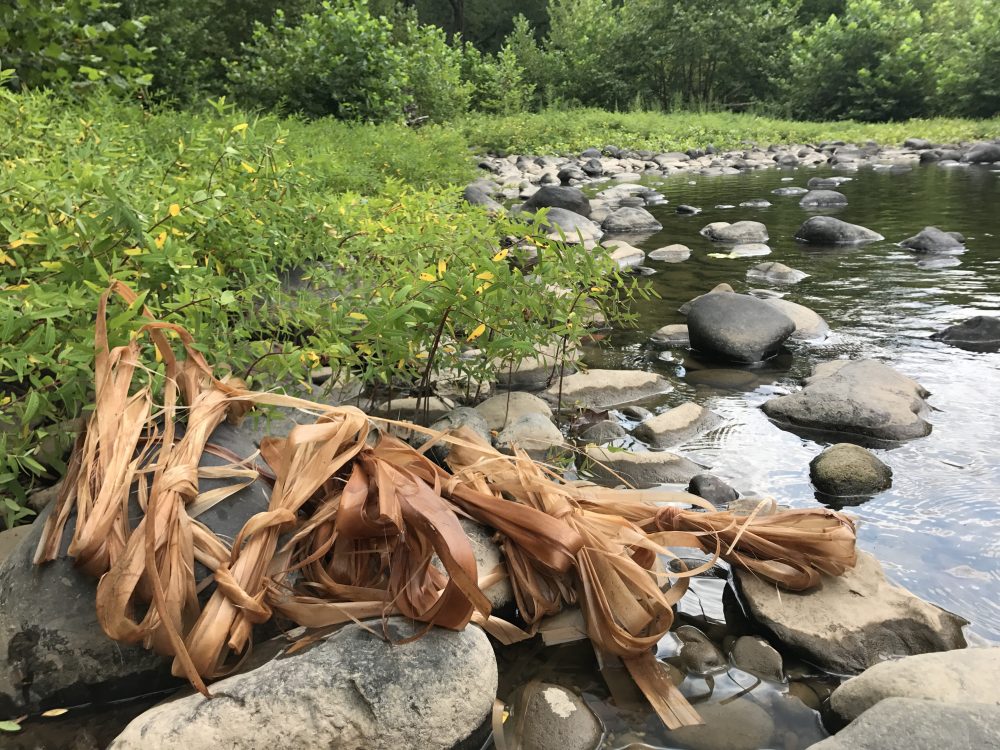
Working with Basswood Fiber: From the Tree to the Basket
I’m sitting in the low water of the Rondout Creek next to my house, with the water flowing past slowly. The sun glints off the water and dances in the most complex and beautiful way. Trees are swaying and cedar waxwings are darting in the blue sky above. In my hands and all around me, floating in the slow moving water are lengths of basswood fiber. Fiber from the bark of a tree I had carefully chosen earlier in the season from the adjacent bank to harvest and process into fiber to be used in making baskets. In this moment I feel completely serene and smile, letting the beauty of this perfect summer day fill me.
This memory of being in the river and rinsing basswood inner bark fiber represents why I do what I do in the deepest way. It was a glimpse of what it feels like to really be a human being on this earth; working with the plants and being in touch with the landscape. The entire process of working with basswood, from choosing a tree to using the fiber in baskets is very dear to me and I want to share that experience with you in this post. As you read below please remember that the plants are our greatest teachers. Just when I think I know something about basswood I get shown a new way by the plant itself! I encourage you to try the process yourself and build your own personal knowledge of working with this wonderful tree. At my 2017 Wild Basketry program I loved seeing participants getting to know the tree throughout the entire season from harvest to completing twined bags at the end of the 8 months we spent together.
Basswood, American Linden, Tilia Americana,
Basswood is the common name of one of our most beautiful native trees in North America, specifically in the region of central New York state where I live. Tilia Americana is the common name, but it is also often called by the name Linden. Besides being a wonderful shade tree the leaves are incredibly rich nutrients and serve to nourish the forest floor each year. And of course its name hints at one of its most valuable purposes: basswood = bast = fiber. The inner bark of the wonderful tree can be removed from the trunk, retted, and made into fiber for a variety of projects. It was valued by many native peoples from the east coast to the Great Lakes region. I wonder… did someone sit in the very river I harvest my basswood from and do the same process three hundred years ago? Tilia as a genus was not only important to North America. A quick glance at wikipedia tells us that there are around 30 species of Tilia throughout the northern hemisphere. In Europe it is commonly known as Linden, or Lime tree. Traditionally it was used to make cordage and other fiber products all across its range. What a truly wonderful tree.
What is Basswood Used For?
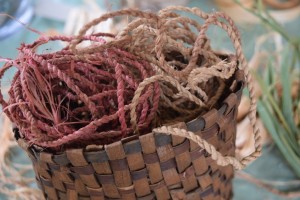
Basswood fiber makes for excellent cordage. The long lengths you can obtain are its main advantage. It may not be as strong as dogbane or as soft as milkweed, but I love the color it’s flexibility. It also takes dye really well.
It is also great for using in twined projects, using as a sewing strand, wrapping, and basically any thing else you can dream of! Recently I’ve also been using the inner bark before it is retted as long flexible stakes for weaving pack baskets. I hope that in a year I can update this post with even more used for this great material! If you are fortunate enough to be surrounded by basswood tree you are indeed lucky and blessed.
How to Harvest and Process Basswood
When to Harvest
I have found that the best season for me to harvest and peel the bark from basswood in my part of the world, which is the Hudson Valley, in New York State, is in June. I have peeled logs as early as May and as late as October and it still works, but is more difficult to separate the inner bark from the wood log.
How to Choose a Tree
The perfect tree is the one that says yes when you ask if it is open to becoming something new. There are many ways to ask a tree if it is ready, but I’ll share my process. First I close my eyes, touch the tree and just ask, either out loud or in thought. Then I step back and really look at the tree and it’s surroundings. Is it part of a cluster of many trees where removing it won’t damage the ecosystem or is it the only basswood in the forest? Is it easy to get to or far out of reach? Will cutting it down damage other trees? Is the tree healthy or struggling to survive? Is there a bird’s nest and its branches? Does it just feel right or wrong? Does it for fulfill the general requirements for a good basket tree listed below? Pay attention to the signs and trust your instincts. Don’t be afraid to hear no and continue looking.
The Specifics of Good Basket Tree
Besides the tree’s readiness to be cut down, you are also looking for physical characteristics which make a tree better for getting long, straight, easy to use fiber. A long, straight trunk with very few branches is ideal. I usually harvest trees between 5 and 10 inches in diameter which are growing tightly in clusters with more basswoods. This being said you can also remove the bark from fallen branches, crooked trees, and other less ideal trees. I recently removed the bark from a large 16″ diameter tree. It was backbreaking work, but so far the bark seems like it’ll be great. Some I used as thicker stakes and some I put in a bin to ret.
Removing the Outer Bark
After you have safely cut down the tree, you can remove any unnecessary branches and either prepare to remove the bark in the field, or move the trunk to your working area. If I have a very long trunk I’ll usually cut it into sections about 10 feet long to carry out. In my process I use a draw knife to first remove the rough great outer bark from the log. You want to get all the scaly gray bark off without cutting too deeply into be inner bark. It’s a fine line and only practice will help you get over the learning curve of this process.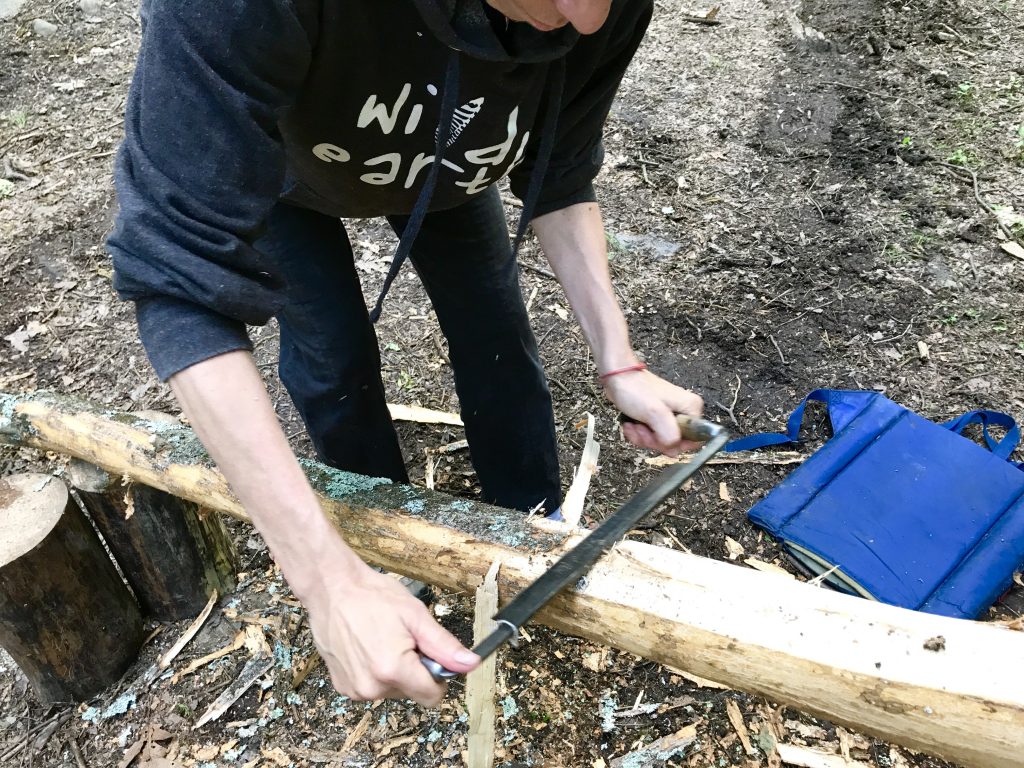
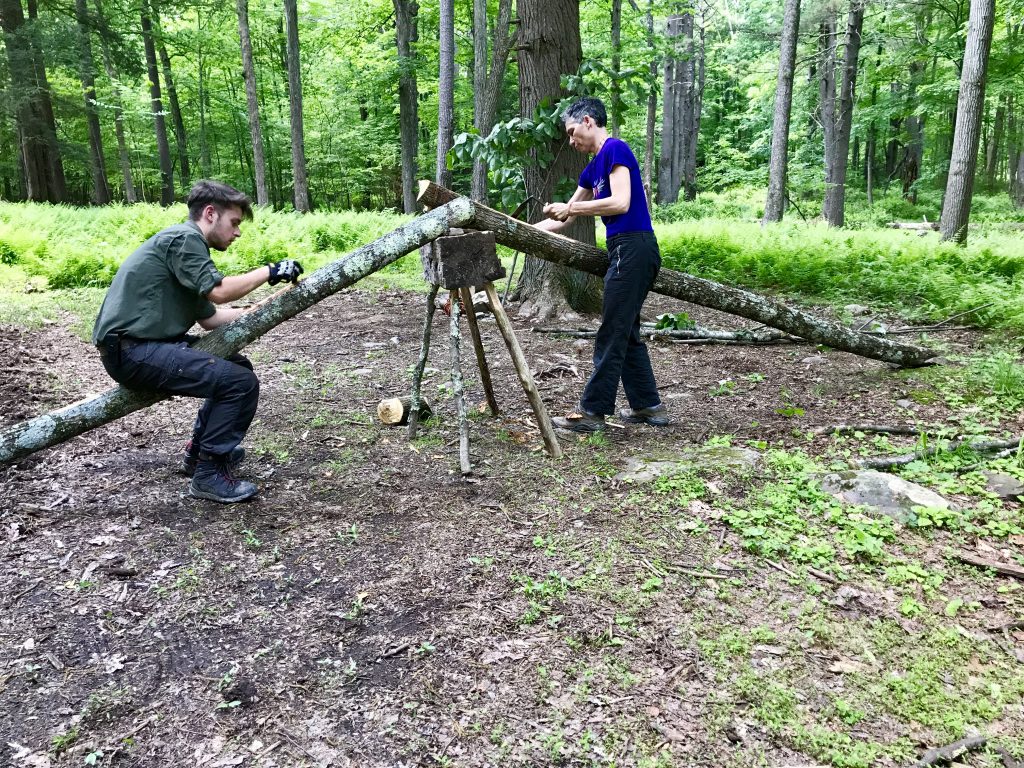
Peeling the Inner Bark Off the Log
Once the log is completely smooth I will cut lines about 4 inches apart down the entire log through the inner bark layer all the way into the wood. Then peel each section up from the log. This is the material that will become cordage after it is retted. The wood you are left with is excellent for carving; soft and easy to work with. Save it or give it to a friend who will make good use of it.
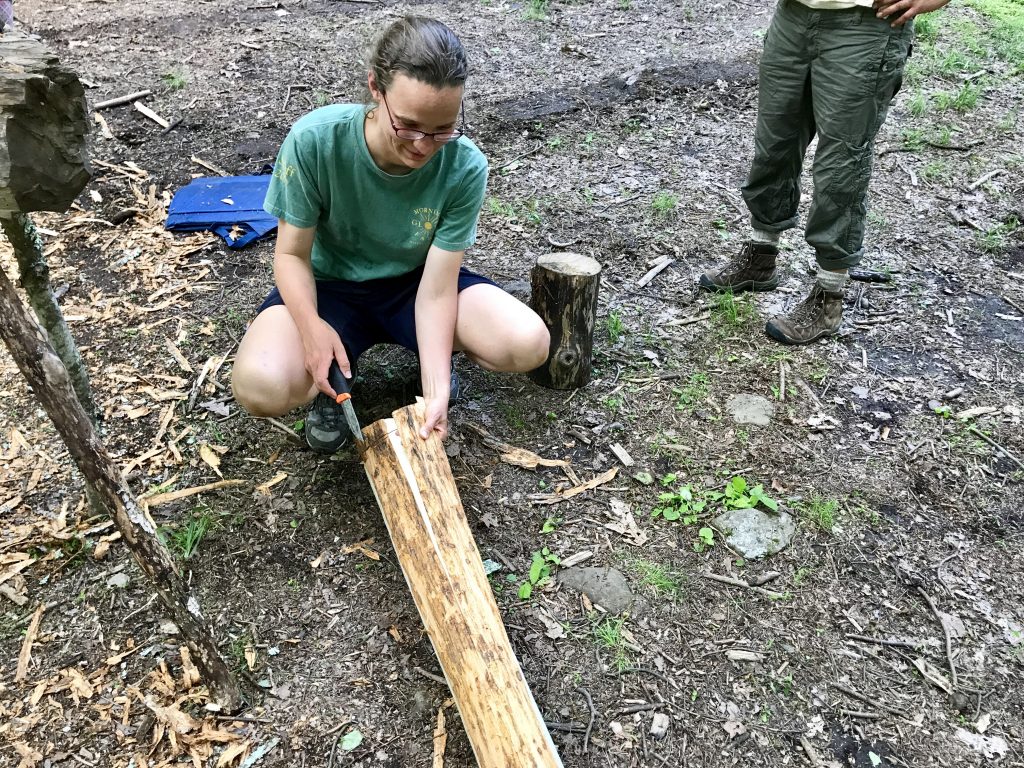
Retting Basswood Fiber
As soon as you have peeled the sections of basswood inner bark from the trunk it is time to put them through a process called retting. Retting sounds alot like ‘rotting’ and in a way that is what is happening. In water retting you submerge the lengths of basswood inner bark in water for a period of 6-8 weeks. During this time microorganisms in the water rot away the cellular tissue and pectins leaving only the long gorgeous strands of bast fiber. It’s a stinky, fun process that is a good way to scare your neighbors away as buckets of rotting bark sit out all summer next to your house! It may end up taking longer than 8 weeks. Just test it and put it back if it’s not done. Sometimes I’ll even peel half of the layers off and then put it back to get the rest of it retted enough to use.
It is best in my opinion to ret your basswood fibers in water that is full of life. River or pond water is great, but if you must use water from the hose the process will still work, but it seems to take longer. I usually take a large tote bin down to the river. First I put the basswood lengths in the tote using the space in the most economical way, by putting coils inside coils until the whole bin is full.
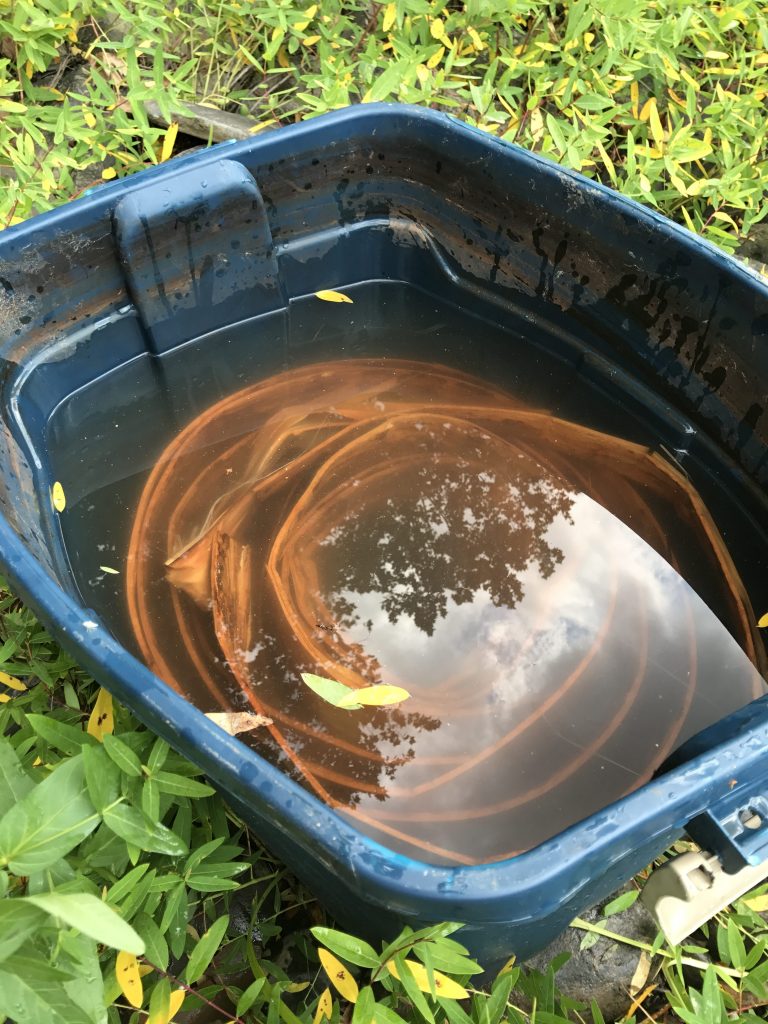
Be gentle when coiling your basswood. If you bend it too sharply it will crack and those cracks will come back to haunt you later when you find your fibers are broken into two foot sections along the length of your beautiful 8 foot piece of bark. Learn from my mistakes and be patient and gentle! Then I use a bucket to fill the bin to the top, making sure it is far enough from the bank that rising water won’t wash it away.
Make sure every single inch is completely submerged with a couple inches of water on top. Do not skimp on this! Even a tiny piece exposed can be a real pain later. Don’t be lazy, and take your time weighing down the pieces with rocks. I was wisely told once that impatience is wanting something for nothing. If it doesn’t all fit then get another bin or bucket. Again I have taken shortcuts and ended up with dry spots in the middle of otherwise perfectly good lengths.
Let the bin of basswood fiber sit for 6-8 weeks, or longer. Check on it to make sure water levels are good. Sometimes if the water gets too nasty I’ll pour it out and refill it. I’m not sure if leaving the same nasty water or changing it periodically is better for the basswood.
When is it ready? You can tell it’s ready when the bark is very flexible when you squeeze it. Give it a test once in awhile and usually after 6-8 weeks it is ready. You can always take one piece out and try rinsing it and if it doesn’t come apart then put it back in for longer.
Rinsing the Basswood Fiber
My favorite way of rinsing basswood fiber is to take the lengths of bark into the river itself. There, rub the bark and bend it and if it is ready soon you will see layers of the bark start to separate. Continue to work it, peeling and rubbing and squeezing it until beautiful, translucent layers of fiber separate along the whole length of the bark. They may feel slimy. Just continue to rinse them until they feel clean and then take each piece or group of pieces and let them dry in the sun. Either before or after they dry I like to bundle each group of pieces neatly so they don’t get tangled in storage. Make sure they are completely dry before storing them. You put so much work into processing and harvesting, not to mention all the work the tree did growing. Don’t let it go to waste and be grateful for every inch of beautiful fiber that you iwll soon be making into beautiful products.
Making bags, cordage, and more
Now you are ready to make some beautiful projects! This post has been about using basswood as fiber for cordage, twining, or sewing specifically. I’m hoping to add more in the future as I learn more. Below are some pictures to hopefully inspire you! Also feel free to share your experiences with basswood in the comments. I’d love to talk to some fellow basket makers about how you use this great material!

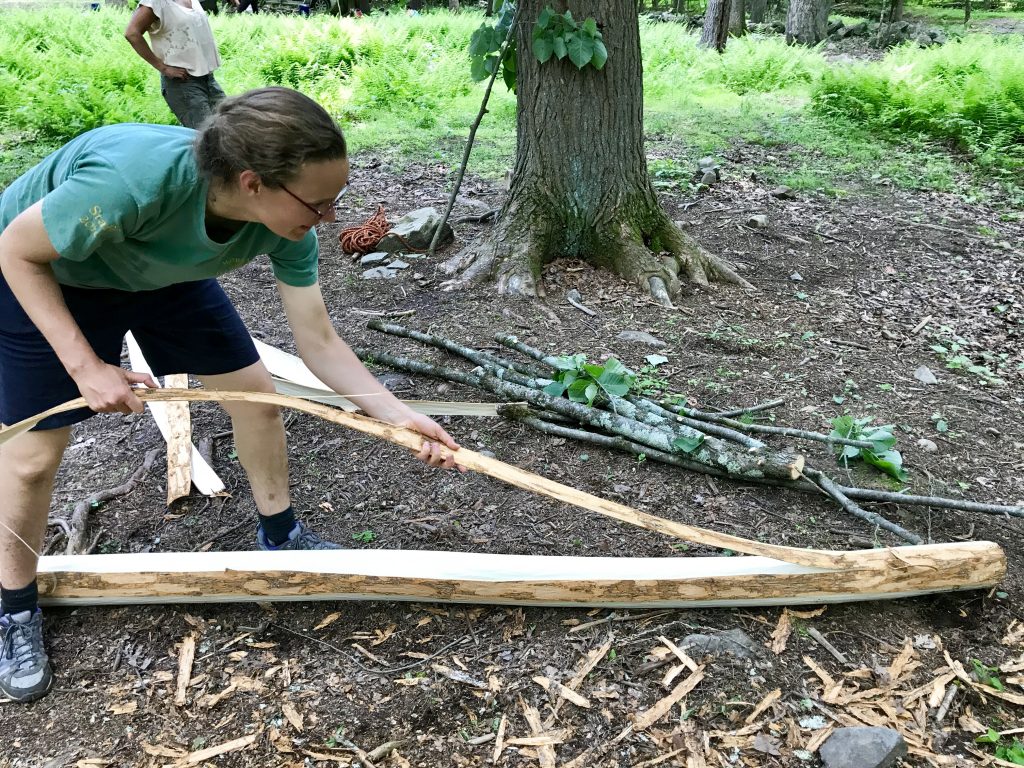

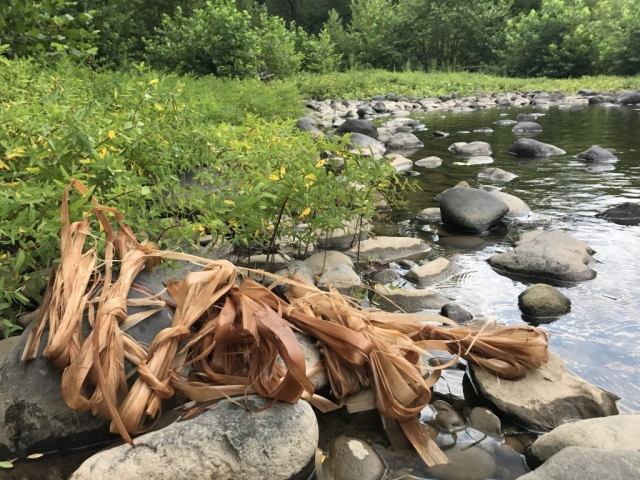
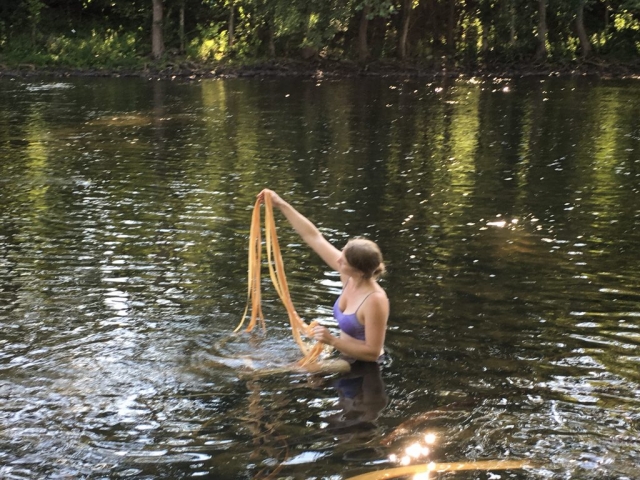

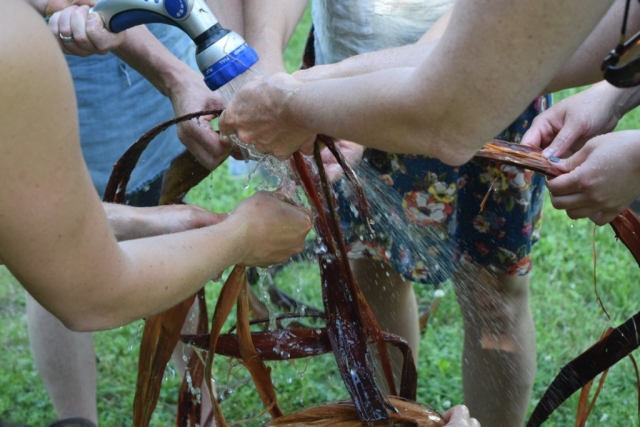
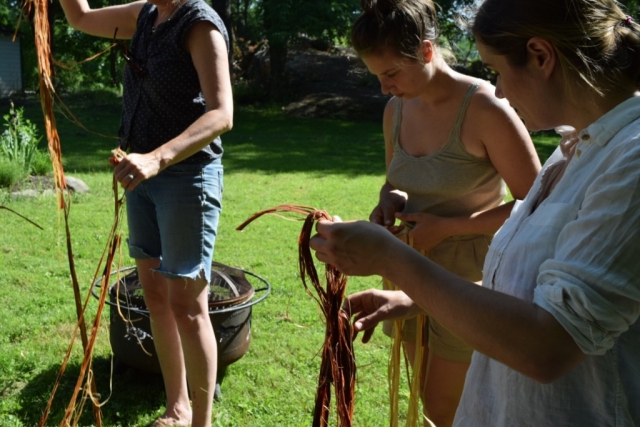
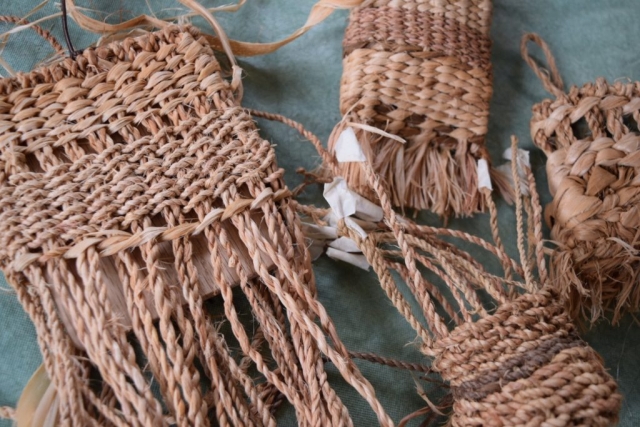
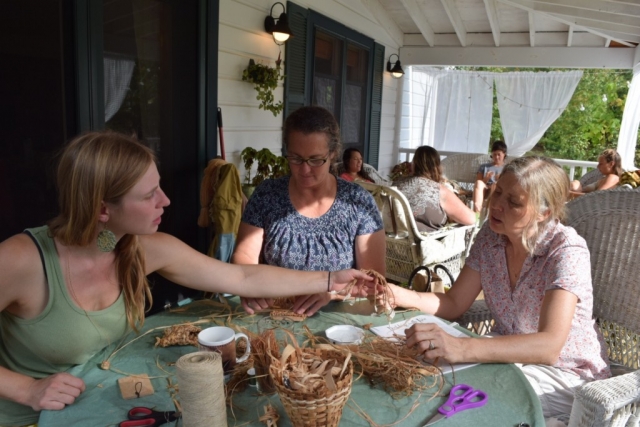
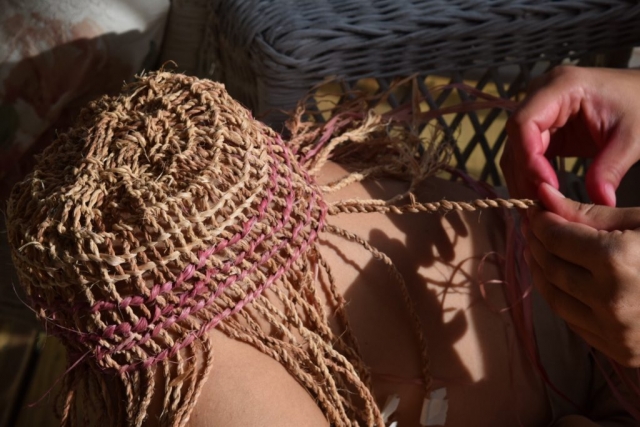
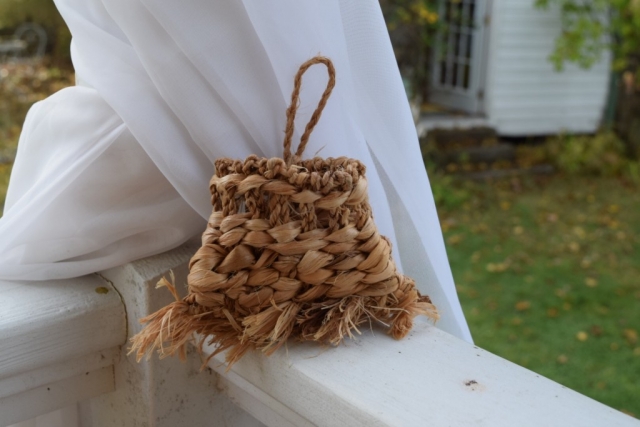
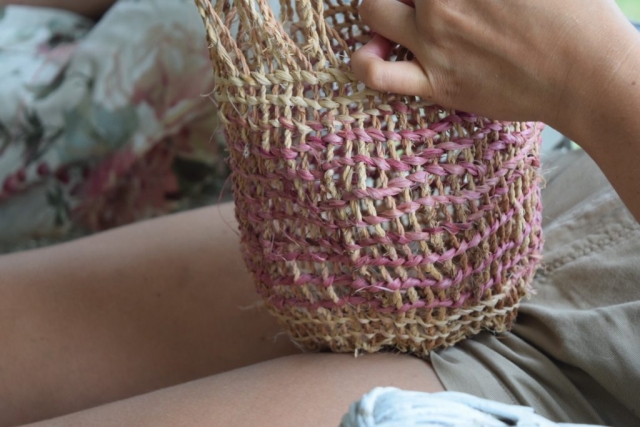
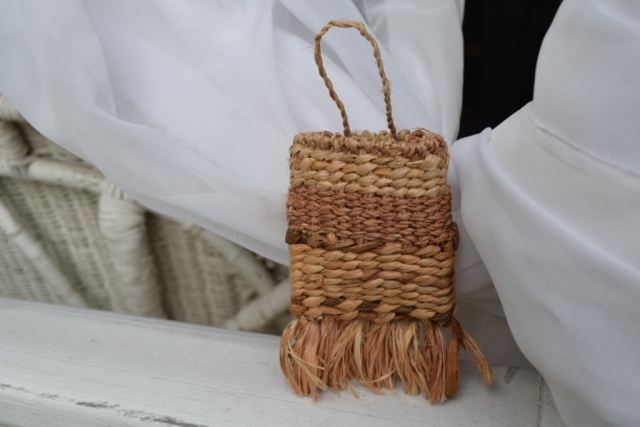
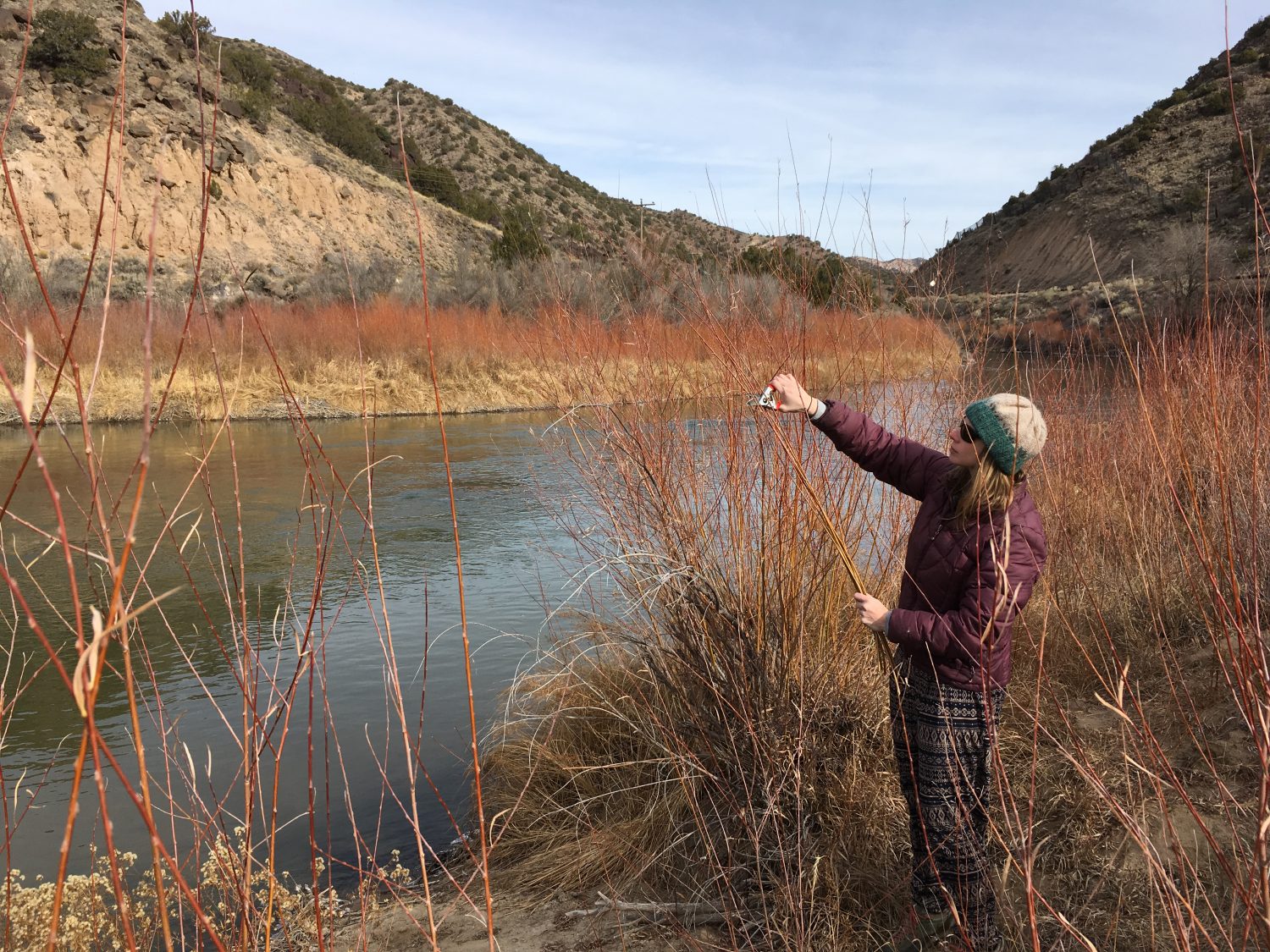
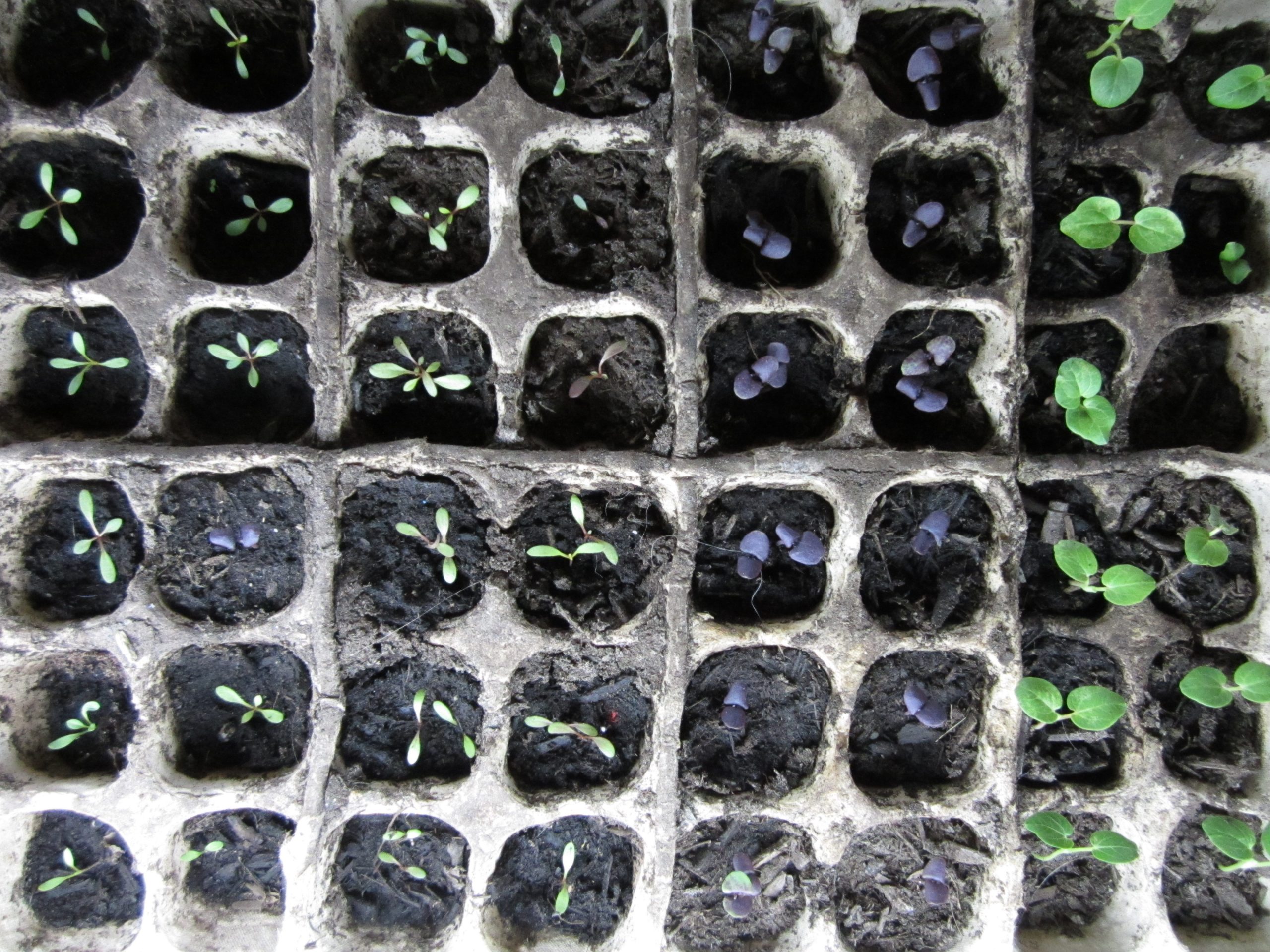
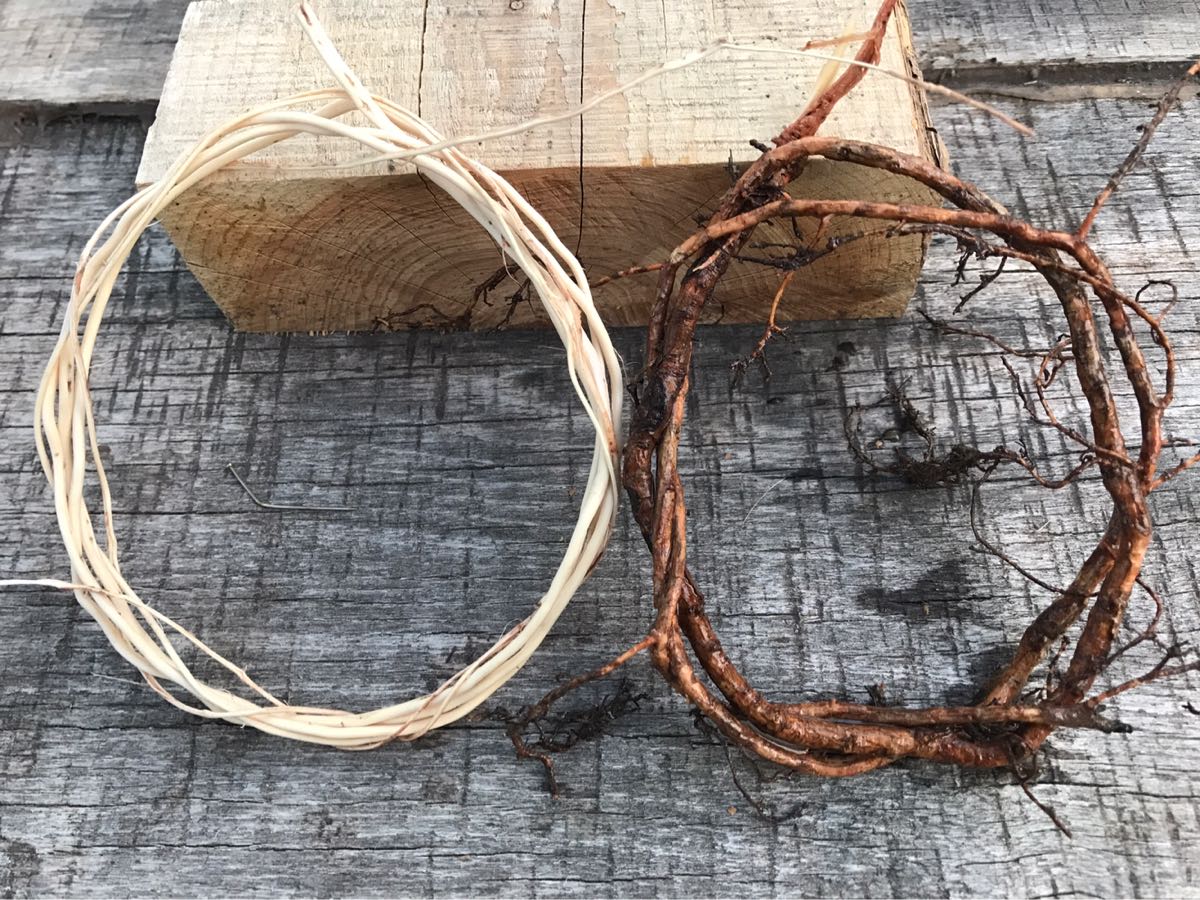
Thank you for this post, your philosophical views about asking the tree tell me that you understand the world similarly to the way I do. I have a deep love for Linden trees, as the stand and give lovely shade and habitat, and as their wood becomes a lovely woodburning pallet, and as their spring leaves become a delicious salad. I especially love to harvest the tasty leaves from the shoots that spring up around the base of the large lindens, knowing that these little attempted clone-trees are a sign of excess, or rather, abundance, for the linden. Basal shoots of other trees often indicate that the tree is sick, and the shoots are a last-gasp attempt to recruit more sunlight for survival; but Basswoods just like to do shoots almost every year. They’re likely to be shaded out, not all that productive, and become deer-nibble; and me-nibble, too.
Recently, we’ve been working on a restoration project where invasive buckthorns have taken over an old oak grove. Happily for me, there are linden saplings mixed in among the buckthorn. Sadly, most of them will need to be cut down at this point in order to have a successful buckthorn-eradication project. So I’ve been taking home the long poles of young lindens, and I’ve just started to get to know the properties of the bark. The fiber cohesion is wonderful! I started soaking the bark strips I removed, and to my surprise and delight, a single bathtub full of water didn’t wash away the sap in the least–it allowed the sap to turn into great big gobs of slime! This slime probably indicates the presence of not only springtime sugars, but also a good lot of starch and amino-acids, protein components that hold together like a thick, clear mucus. I’m very amused, and had a great time showing my daughter the mucilage!
Next time I get to this stage, I’m thinking to save the water and slime from the first soaking. I’m curious if it has the same sort of medicinal qualities as the mucilage in-between cattail leaves; something to soothe a sunburn.
Thanks so much for the introduction to how to best rett the fibers! I’ll give it a try in the pond nearby, should be an interesting project with a good long time-frame to learn as I go.
Be well, Teacher!
Thank you so much for the wonderful stories you shared! I love that you were able to use saplings that would otherwise be cut down and left. Also find the idea of the leftover mucilage being soothing and purposeful- it does smell pretty strongly though! Would really enjoy hearing any updates you have as you continue the journey of learning with our dear friend the basswood : )